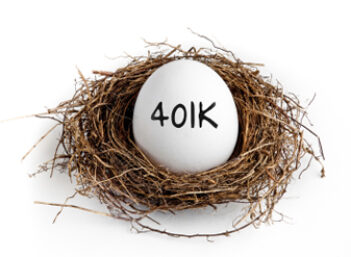We tend to think of 401(k) plans as the bedrock of the retirement savings system.
But these plans, named after a section in the Internal Revenue Code, were actually developed more by accident than by design. When lawmakers originally established the Revenue Act of 1978, the goal was to limit executives at some companies from having too much access to the perks of cash-deferred plans. (Why, you ask? Since the 1950s, companies had been fighting with the Internal Revenue Service to allow more money to be squirreled away in such plans.)
The accidental birth of the 401(k) can be credited to Ted Benna. In 1980, the benefits consultant used his interpretation of the law to create a 401(k) plan for his own employer, The Johnson Cos., that allowed full-time employees to fund accounts with pre-tax dollars and matching employer contributions. Benna then asked the Internal Revenue Service to change some proposed rules under the law that ultimately led to the widespread adoption of 401(k) plans by employers in the early 1980s.
'I knew it was going to be big, but I was certainly not anticipating that it would be the primary way people would be accumulating money for retirement 30 plus years later,' Benna, now semi-retired and the president of the 401(k) Association, told Workforce magazine.
The 401(k) Grows Up: A 30-Year Timeline
In the early 1980s, 401(k) plans were only available at a handful of large companies, such as Johnson & Johnson. Today, some 94% of private employers offer them.
A 401(k) plan is a retirement account that you can only access through an employer. You contribute a portion of your salary to the plan, and if you choose to put that contribution in a traditional 401(k), it isn’t taxed until you withdraw the money, allowing your investments to grow over time without being taxed. (Note: You will pay penalties if you take out the money before a set retirement age, as defined by the plan.) And, as an added bonus, many employers will match some of your contributions.
In its relatively short history -- just 30 years! -- 401(k) plans have had many milestones:
1978: Congress passes the Revenue Act of 1978, which includes a provision that allows employees to avoid being taxed on a portion of income that they decide to receive as deferred compensation, rather than direct pay. The provision becomes Internal Revenue Code Sec. 401(k).
1981: The I.R.S. issues rules allowing the funding of 401(k) plans through employee salary reductions.
1982: Several companies—such as Johnson & Johnson, PepsiCo and Honeywell -- begin to offer 401(k) plans to their employees. By 1983, nearly half of all large employers either offer a 401(k) plan or are considering offering one, according to the Employee Benefit Research Institute.
1984: The Tax Reform Act of 1984 requires “nondiscrimination” testing to prevent 401(k) plans from favoring highly compensated employees over rank-and-file workers. At the time, Congress was concerned that executives would take advantage of 401(k) plans more than lower-paid employees.
1996: Assets in 401(k) plans surpass $1 trillion, with more than 30 million participants.
2001: The Economic Growth and Tax Relief Reconciliation Act of 2001 provides for catch-up contributions for participants 50 and older, as well as the creation of Roth 401(k)s, which let after-tax contributions grow tax-free.
2006: The Pension Protection Act of 2006 allows employers to automatically enroll employees in 401(k) plans, and offer target-date funds as a default option.
Today’s 401(k): Too Big For Its Britches?
The current 401(k) stats are staggering:
- 51 million Americans have more than $3.5 trillion invested in 401(k) plans, which is more than double the $1.6 trillion in assets held by the plans in 2002, according to the Investment Company Institute.
- Assets in 401(k) plans represent 18% of the $19.4 trillion U.S. retirement market.
- The average account balance in a 401(k) plan reached $80,900 in the first quarter this year. According to Fidelity Investments, a large 401(k) plan administrator, that’s up 75% from $46,200 during the market low in the first quarter of 2009.
Benna, who’s referred to as the 'Father of the 401(k),' has actually been critical of his creation as of late, noting that there are too many investing options available today and that their complexity has a negative impact on 401(k) plan participants.
'This monster is out of control. We went to three options, then to six, then to seven, then to 15 -- it is far beyond what most participants were able to deal with,' Benna told SmartMoney magazine. 'And I am not convinced we have added value by getting more complicated.'
The original 401(k) plan had only two investing options: a stock fund and a fund that guaranteed a return similar to a money market fund. The typical 401(k) now offers 19 funds.
Some employers have been working to simplify 401(k) plans by limiting the number of funds on a plan’s investment menu, as well as automatically enrolling workers into target-date funds, which adjust a portfolio of stocks and bonds as a participant approaches retirement to reduce risk. Today, nearly 70% of 401(k) plans offer a target-date fund as a default option, with about 12% of 401(k) assets invested in such funds.
The 401(k) Effect: Did These Plans Kill Pensions?
As 401(k) plans have thrived, traditional pension plans have declined. According to the Department of Labor, from 1980 to 2008, the proportion of private workers participating in traditional pension plans fell from 38% to 20%.
For employers, 401(k) plans are a more enticing option because they cost less than traditional pension plans, and they don’t carry the same accounting liabilities and investment risks. Some 401(k) critics even say that workers would be better off in traditional pensions.
'We know after 30 years of this 401(k) experiment that people do worse in 401(k)s than they would have if their money was in a traditional plan or if it was in a plain vanilla retirement account,' Teresa Ghilarducci, director of the Schwartz Center for Economic Policy Analysis at The New School for Social Research, told PBS’s Frontline in April.
But pensions were never as widely available as 401(k) plans. 'Even in the 'good old days' when 'everybody' supposedly had a pension, the reality is that most workers in the private sector did not,' writes Nevin Adams of the Center for Research on Retirement Income at the Employee Benefit Research Institute. 'Even among those who did work for an employer that offered a pension, most in the private sector weren’t working long enough with a single employer to accumulate the service levels you need for a full pension.'
As a result, notes Adams, most workers who have pensions still rely on a combination of Social Security and personal savings, in addition to pension income to fund their retirements... and the number of 401(k) plans continues to grow.
How to Make the Most of Your 401(k)
Despite the growth of 401(k) plans, there’s an estimated $6.6 trillion deficit in what Americans currently have in savings compared to what they will actually need in retirement, according to an analysis by the Center for Retirement Research at Boston College.
This shortfall should make maximizing retirement accounts, like a 401(k) plan, a priority. As of 2013, you can contribute up to $17,500 into a 401(k) plan, and put in $5,500 more if you’re 50 or older.
If you’re not maxing out your 401(k), you should consider boosting your contribution by 1% every six months. For most of us, that’s about $20 to $50 per paycheck, which you probably wouldn’t miss much. And since most employers will automatically deduct a 401(k) contribution from your paycheck, it makes the extra savings easier to stomach.
Your employer may also offer to help you save more: Some 95% of 401(k) plans provide matching contributions, and the average company contribution is 2.5% of an employee’s pay. Matching policies among 401(k) plans differ depending on the company, but the most common is a dollar-for-dollar match of up to 6% of an employee's pay.
The Investing Answer: Even if you have a good 401(k) plan, the most important thing to do is to start saving more now because it's hard to make up for lost time when it comes to building a healthy retirement nest egg.



